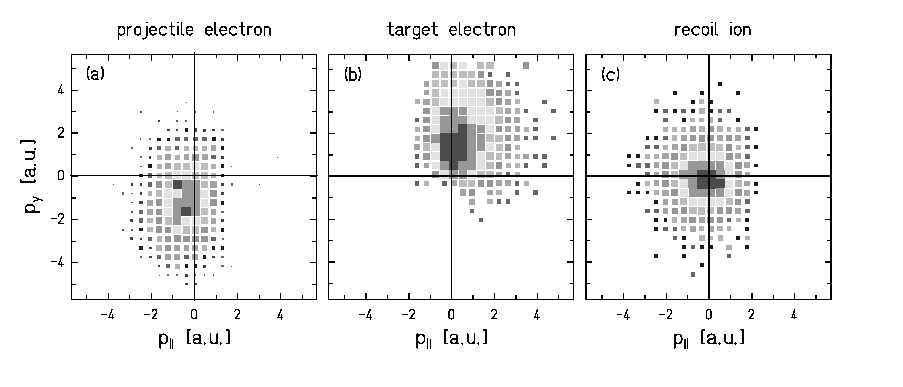
Figure 1:
The momentum distributions of the projectile electron (in the projectile frame),
the target electron and the He1+ recoil ion projected onto the collision plane.
Electron-Electron Interaction in Projectile Ionization: A New Way to Explore (e,2e) on Ions?
H. Kollmus1, S. Hagmann2,4, R. Moshammer3, R. Mann2, M. Schulz5, R.E. Olson5 and J. Ullrich1,3
1 Fakultät für Physik, Universität Freiburg, 79104 Freiburg, Germany
2 Gesellschaft für Schwerionenforschung (GSI), 64291 Darmstadt, Germany
3 Max-Planck-Institut für Kernphysik, Saupfercheckweg 1, 69117 Heidelberg, Germany
4 JRM, Kansas State University, Manhattan, USA
5 University of Missouri, Rolla, USA
Measurements of differential cross sections for ionization of ions in collisions with high-energy electrons are extremely diffcult to perform by applying conventional crossed beams techniques. In essence, due to the low luminosity, such experiments have not been feasible up to now, not even in storage rings. They would allow high precision momentum spectroscopy of bound states in few-electron heavy ions.
On the other hand, in a fast collision of a non-bare projectile ion with a target atom the projectile can be ionized via an interaction with one of the target electrons (electron-electron (e-e) interaction). In such collisions both, the active target electron and the projectile electron, get ionized [1]. This process is equivalent to electron impact ionization of the projectile if the initially bound target electron can be treated as a quasi free electron. In such a scenario, using a dense atomic beam, one would circumvent the above mentioned low luminosity problem. But, there is a second mechanism contributing to projectile ionization: It might be ionized by an interaction with the target nucleus (nucleus-electron (n-e) interaction). Thus, electron impact ionization of ions may be studied in great detail, if the many-particle dynamics is completely controlled experimentally.
We performed such a measurement at the UNILAC of GSI. Using the reaction microscope [2] ionization of 3.6 MeV/u C2+ projectiles in collisions with He was investigated in a kinematically complete experiment. The final state momentum vectors of each particle have been mapped. In this contribution we will demonstrate that a separation of the two competing mechanisms to projectile ionization is possible because of their different collision dynamics. If a (n-e) interaction takes place the target nucleus has to deliver the momentum transfer required to ionize the projectile. Thus, one expects a recoiling He1+ target ion with large momentum, whereas the target electron acts as a spectator. In contrast, in a (e-e) interaction the target electron plays the active role and the He nucleus takes part as a spectator. Therefore the two processes ((n-e) and (e-e)) can be separated event by event by putting a condition on the values of the momenta jpj of target electron and He1+ ion.
Selecting only those events, for which petarget > pion is fulfilled, implies that mainly the (e-e) interaction is left in the resulting subset of the experimental data. The validity of this approach is demonstrated in the figure. There the momentum distributions of the projectile electron (a), the target electron (b) and the He1+ recoil ion (c) are projected onto the collision plane. This plane is defined by the incoming projectile momentum and the momentum transfer vector q=qion + qetarget of positive y-values. In the current experiment the kinematic region of small momentum transfer is dominating the observed cross section. As expected for the (e-e) interaction, the ionized projectile electrons and the target electrons are preferentially emitted into opposite directions. The target ion behaves as a spectator and therefore exhibits no angular correlation with the emitted electrons.
The experimental data are in very good agreement with first purely classical (CTMC) calculations. According to these calculations more asymmetric collision partners are required to fulfill the equivalence to electron impact ionization. Such experiments will be performed in near future in the storage ring ESR at GSI using one-electron heavy ions and light or even excited targets as a dense electron target.
Figures:

Figure 1:
The momentum distributions of the projectile electron (in the projectile frame),
the target electron and the He1+ recoil ion projected onto the collision plane.
References:
1) R. Dörner et al., Phys. Rev. Lett. 72, 3166 (1994)This work was supported by the Gesellschaft für Schwerionenforschung, Leibniz-Programm,
2) H. Kollmus et al., Nucl. Instr. Meth. B124,377 (1997)
This work was supported by the
Chemical Sciences, Geosciences and Biosciences Division,
Office of Basic Energy Sciences,
Office of Science,
U.S. Department of Energy.
Submitted to ICPEAC 2001, July 2001 in Santa Fe, NM.
This abstract is also available in Postscript or Adobe Acrobat formats.
|
|